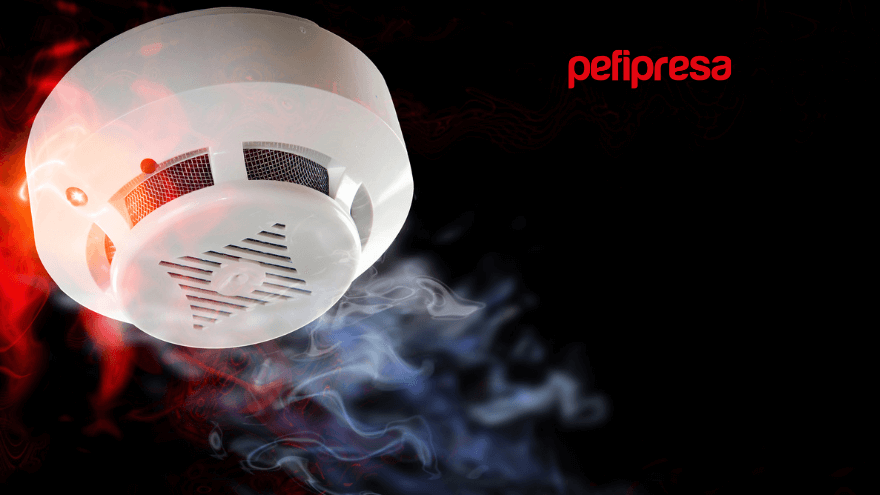- Smoke detectors: optical, photoelectric and ionic.
- Temperature detectors: thermal and thermovelocimetric.
- Flame detectors: infrared, ultraviolet and combined IR+UV.
- Linear infrared detectors.
- Gas detectors.
- Detector cable or temperature sensor for fires.
What is a fire detector, definition
A fire detector is a device that detects the presence of a fire. This can be done in several ways, including the following:
- Smoke detectors use an optical or electrochemical sensor to detect smoke.
- Combustible gas detectors use an electrochemical cell or catalytic sensor to detect combustible gases in the air.
- Ionization smoke detectors are capable of detecting large and small particles in the air, as well as large amounts of smoke. Disused due to the use of radioactive components.
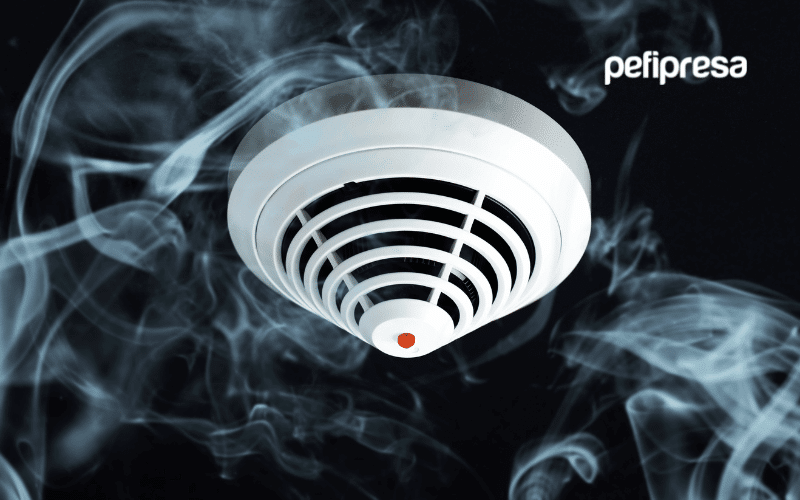
What is a fire detection system
A fire detection system is an electronic system made up of different types of devices and whose objective is to preventively detect a fire in its most incipient phase, and to issue alarm signals to the user personnel of the installation to try to prevent it from spreading.
These systems are normally made up of a central processing unit, known as a Fire Panel, auxiliary elements such as modules or power supplies, and field elements such as alarm buttons, sirens and detectors.
The functions included in a Fire Detection and Alarm System are found in EN 54-1 Fire detection and alarm systems. Introduction.
A fire detection system can constitute an independent system in itself (small installations) or form part of a larger system (medium or large installations). An example of a small system might be a home system, where smoke detectors can be linked to each other and to your home security alarm, so that when a detector activates its alarm, it reaches the user through the control panel.
The larger and more complex systems can be, for example, multi-bay or multi-building installations, with several fire panels interconnected with each other through a redundant network, where a combination of detection and communication according to the fire forecast of each location.
The installations can also be of the conventional or analog type, the first of which is a system in which several detectors are joined together to emit an alarm, normally ignoring the exact presence of the start of the fire. It is the simplest system. On the other hand, the much more technologically developed analog system unequivocally identifies the triggering of the alarm, so it is known exactly which detection system equipment has communicated or detected the fire warning.
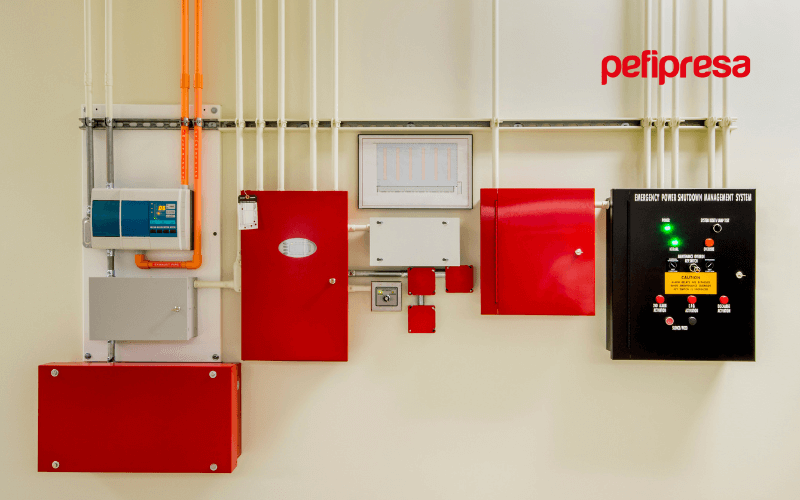
1. Smoke detectors: optical, photoelectric and ionic
Optical smoke detectors
An optical smoke detector is a device that detects smoke generated in a fire and is drawn into the detector, so that by using light-emitting diodes (LEDs) to illuminate the surrounding area of the smoke chamber detector analysis. The LEDs are connected to a photodetector, typically a photodiode array or a single photodiode. The photodiode converts the reflected light into electricity, and the generated voltage is used to determine if there is smoke in the protected location.
They are the most widely used detectors due to their versatility, and are especially indicated in locations where a fire that quickly generates smoke can be expected, such as fabric warehouses , wood, and in general almost any product that does not have liquid, gaseous or chemical components.
A widely used variety is the optical-thermal dual technology detector, for locations that generate smoke during normal use, such as a car park, so that the detector will activate an alarm once both technologies have exceeded their limits. thresholds.
Photoelectric smoke detectors
These detectors use light to detect smoke, but respond faster than optical detectors because the detection technology is simpler: no need for an LED or laser beam to scan the camera, as would be the case with an optical model. The speed with which these devices react makes them ideal for areas where protection against fires that are expected to grow rapidly is needed, such as kitchens.
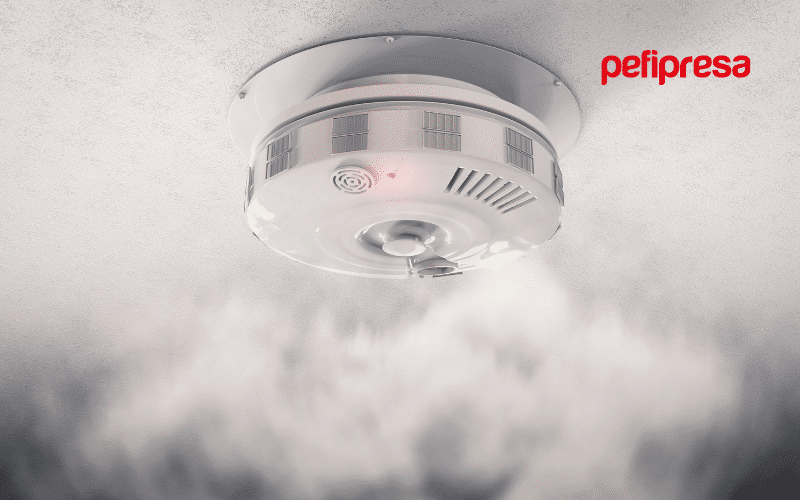
Ionic (or ionization) smoke detectors
These devices are similar to photoelectric devices in that they respond quickly without relying on a complicated scanning mechanism; however, its sensors work by measuring ion levels in the surrounding air, not visible light as its counterpart technologies do.
This means that ionic detectors tend to be more effective in fires where a large amount of smoke is not expected, being especially used in chemical environments, although it should be noted that it is a type of detector that is currently withdrawn from the market, due to environmental restrictions, since it is an element that uses a small amount of radioactive material to function, so there is a tendency to replace it and special waste management.
Aspiration detector systems
It is not a type of detector that uses a technology other than optical or ionic, but rather these are systems that are made up of a detectorwith different detection technologies to which the smoke is conducted through a system of pipes and suction pumping to the analysis area.
This equipment manages to cover large areas and volumes, and its operating principle is to suck in air from the protected area through calibrated holes in a pipe system, so that it reaches the detector chamber in yes, and so in case of detecting smoke, depending on the technology available, it will activate or generate the corresponding alarm to the fire detection and alarm system.
2. Temperature detectors: thermal and thermovelocimetric
Thermal detectors
They are used to detect high temperatures, activating an alarm signal once the predefined temperature threshold has been exceeded in your camera.
These sensors can be platinum resistance thermometers (PRTs) or thermocouples, which detect temperature change in a wire.
They are especially indicated in locations where high temperatures occur during normal activity or where there are sudden increases in temperature, such as ovens or kitchens.
Thermovelocimetric detectors
The thermovelocimetric (TV) classes of fire detectors are a type of smoke detector that uses a thermistor to detect the temperature rise of a fire. A thermistor is a semiconductor whose electrical resistance varies with temperature. The thermistor is placed in a stream of air and connected to an electronic circuit, which measures changes in voltage as the temperature of the air increases. When smoke enters the air stream, it absorbs heat and lowers its temperature. This causes the change in voltage measured by the thermovelocimeter detector circuit, which activates an alarm signal.
The most common use of this type of detector is in car parks where you do not want to use the optical-thermal one or in kitchens where the normal thermal one is not used and where it is not foreseen that there may be sudden changes in temperature such as an oven
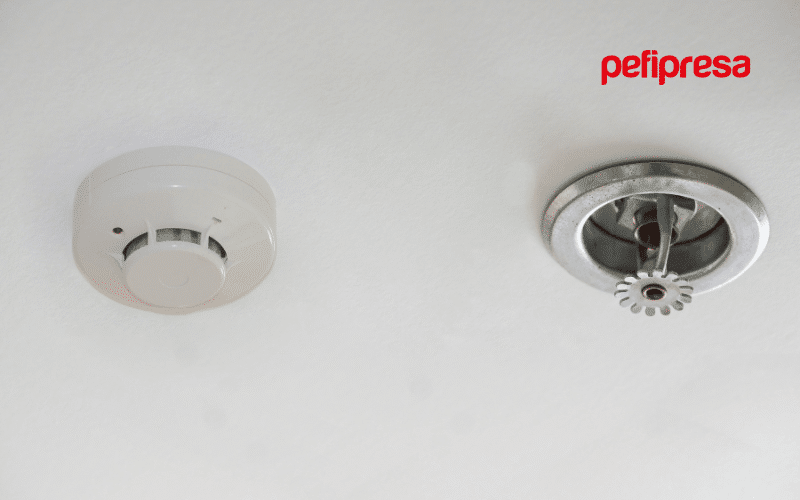
3. Flame detectors: infrared, ultraviolet and combined IR+UV
IR infrared flame detectors
An infrared (IR) flame detector is a device that detects infrared radiation (heat) emitted by flames. Infrared flame detectors contain an emissive sensing element that converts infrared radiation into electrical output signals.
UV ultraviolet light flame detectors
Ultraviolet flame detectors use a combination of light sensors, filters, and photodetectors to detect the ultraviolet light emitted by flames. A beam of light is directed through the area monitored by the detector and if an object blocks the light in any way, it will cause a break in the beam and trigger an alarm. The detector can also be used to detect smoke using an infrared filter that removes all visible light from the beam.
Ultraviolet flame detectors are the most suitable for use in areas with risk of fire or explosion, such as oil refineries, chemical plants and warehouses. They can also be installed in kitchens.
Combined infrared plus ultraviolet IR+UV flame detectors
Combination Infrared and Ultraviolet Flame Detectors are a type of fire detector that uses ultraviolet and infrared light technology to detect the presence of flames.
These detectors are commonly used in areas where there are sparks or flames, such as kitchens, bathrooms, garages, utility rooms and workshops.
4. Linear infrared detectors
Linear infrared detectors or commonly called “smoke or linear barriers” are a type of detector that uses beams of infrared light to detect objects. The detector is made up of two parts: an emitter and a receiver. The emitter is a device that emits infrared rays, while the receiver detects the reflected rays.
When an object obstructs the path between the emitter and the receiver, the light beam is interrupted. This interrupt is detected by the controller and used by the controller to trigger an alarm or other action.
Linear infrared barriers can be installed at entry points such as doors or gates, although their main use is for the protection of large areas such as warehouses, where a typical installation of detectors optical or thermal could mean a huge installation cost.
Other elements that are installed in large areas are aspiration detection systems, which we have already analyzed above.
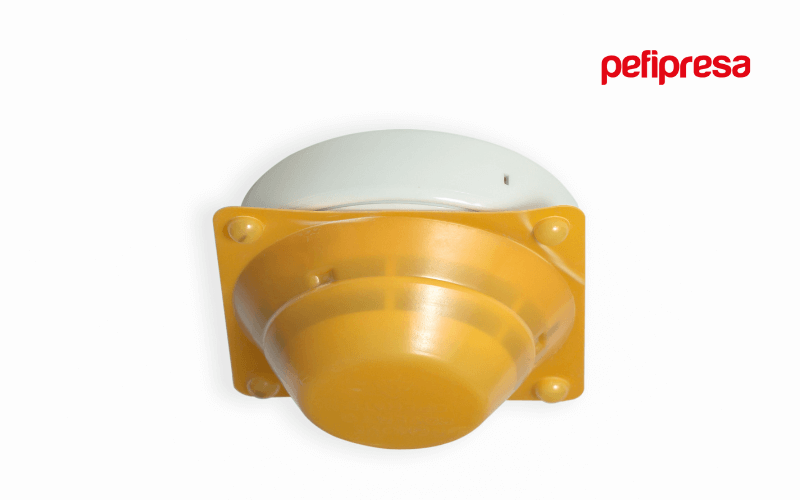
5. Gas detectors
Gas detectors are used to detect the presence of combustible gases. Gas detectors are used in industrial applications, but are also becoming more common in residential applications.
Gas detectors are designed to detect the presence of explosive and toxic gases. A good example is carbon monoxide (CO). Carbon monoxide is a colorless, odorless gas that can kill if present in high enough concentrations.
Especially indicated in habitual smoke and CO areas such as a car park, or advisable in homes if they have combustion heating systems.
6. Fire detector cable or temperature sensor
The cable of a fire detector or temperature sensor is made up of two parts: the primary and the secondary conductor. The primary conductor is usually copper, while the secondary is aluminum.
The two conductors are separated by an insulator which prevents them from touching and creating a short circuit. In addition, it also prevents fire or smoke from reaching the control panel, where it could damage it or cause it to shut down prematurely during a fire emergency.
There are two types of connection methods used for this type of detector: single pole and multipole connections.
This type of detector is usually installed on the ceiling or wall.
Temperature sensors in general are devices that measure the temperature by contact of a surface, a liquid or a gas. They have many applications, such as controlling the temperature of an engine’s coolant so that the engine does not overheat. Temperature sensors are also used in heating, ventilation and air conditioning systems to ensure that the temperature remains at a comfortable level for the occupants.
Many cars use a thermistor to control the temperature of their heating systems. The sensor is attached to a circuit board inside the car and when it detects that the temperature has dropped below its set point, it turns on the heating.
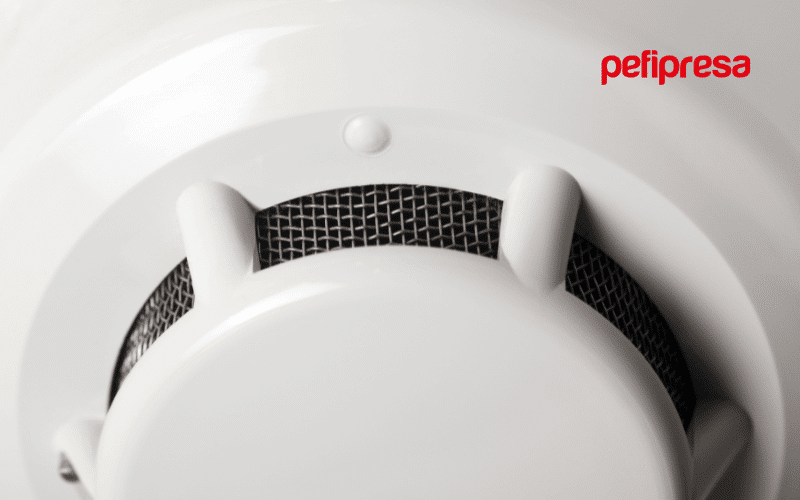
How to choose the most suitable type of fire detector
Before carrying out any fire project, we must know perfectly certain characteristics of the premises or enclosure to be protected:
- Regulations of application.
- Size of the installation
- What is the purpose of the detector? Is it to detect smoke, heat, gas?
- What is your environment like and what type of fire is expected in that location?
- What level of risk do we have in our building/house/business/etc.?
- What technical, economic or production consequences could the fire have in the protected area, zone or equipment?
- What is your budget?
Depending on the answers, the system should be considered as a global solution considering the type of detectors appropriate to the risk of each particular location, following the instructions that we have indicated in each of the types of fire detectors that usually exist on the market.
As a fire detection system is made up of different types of detectors, each designed to detect one or more types of fire, the correct choice of the most suitable type of detector will depend on the area to be protected and of the type of danger present in that space.
If you need help choosing the most suitable fire detection system or type of detector for your project, contact us and we will be happy to help you analyze your requirements and find a suitable solution that meets your needs.

